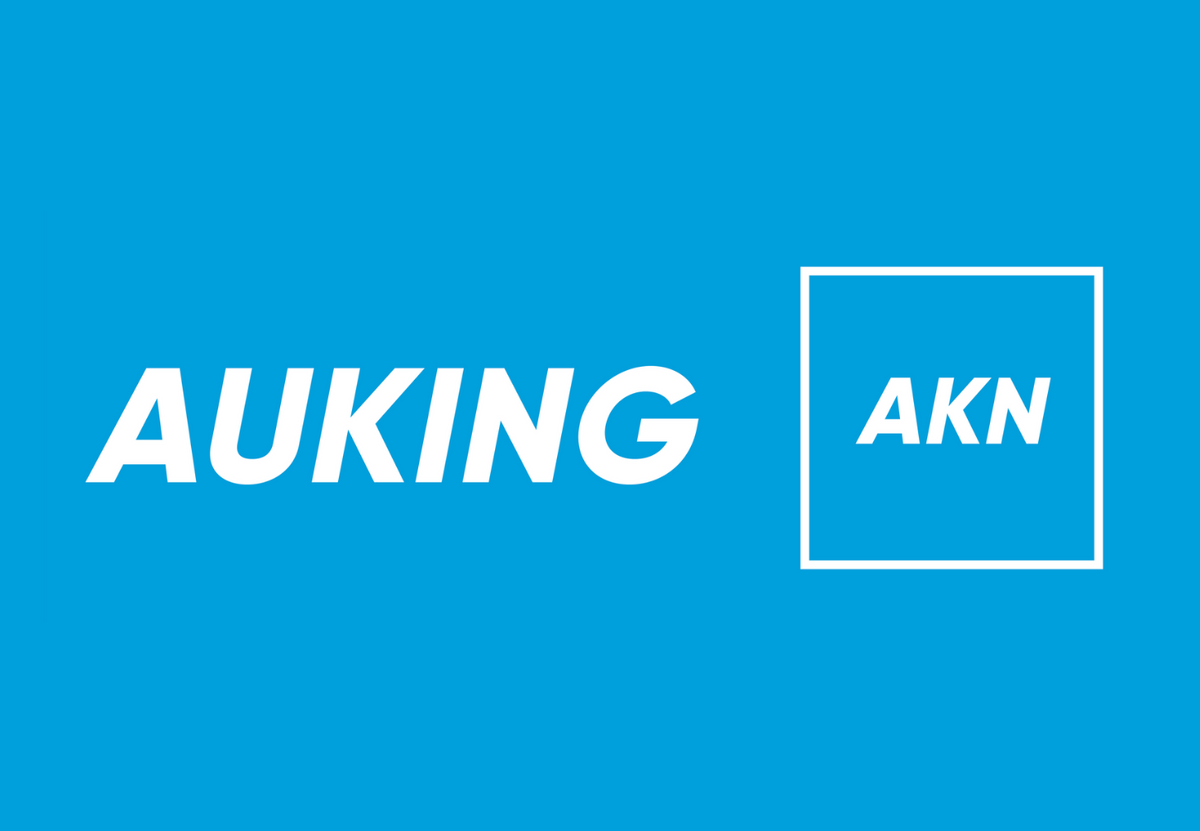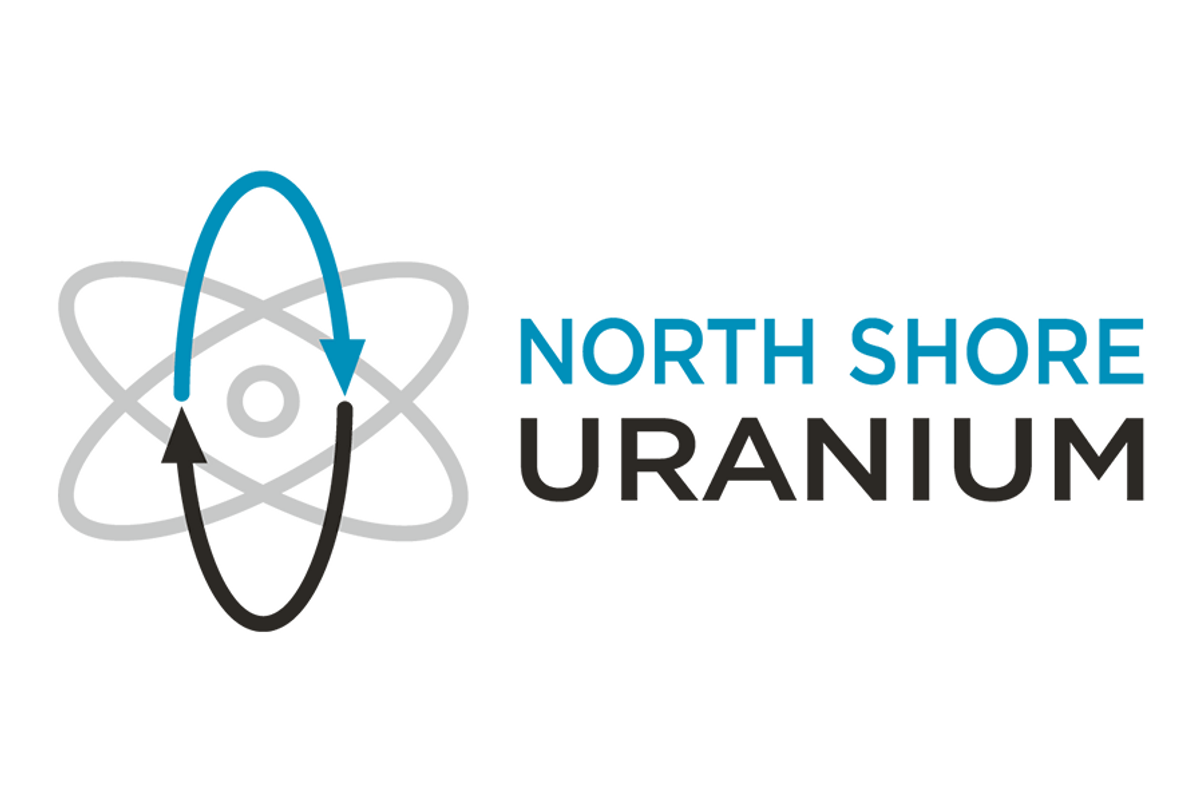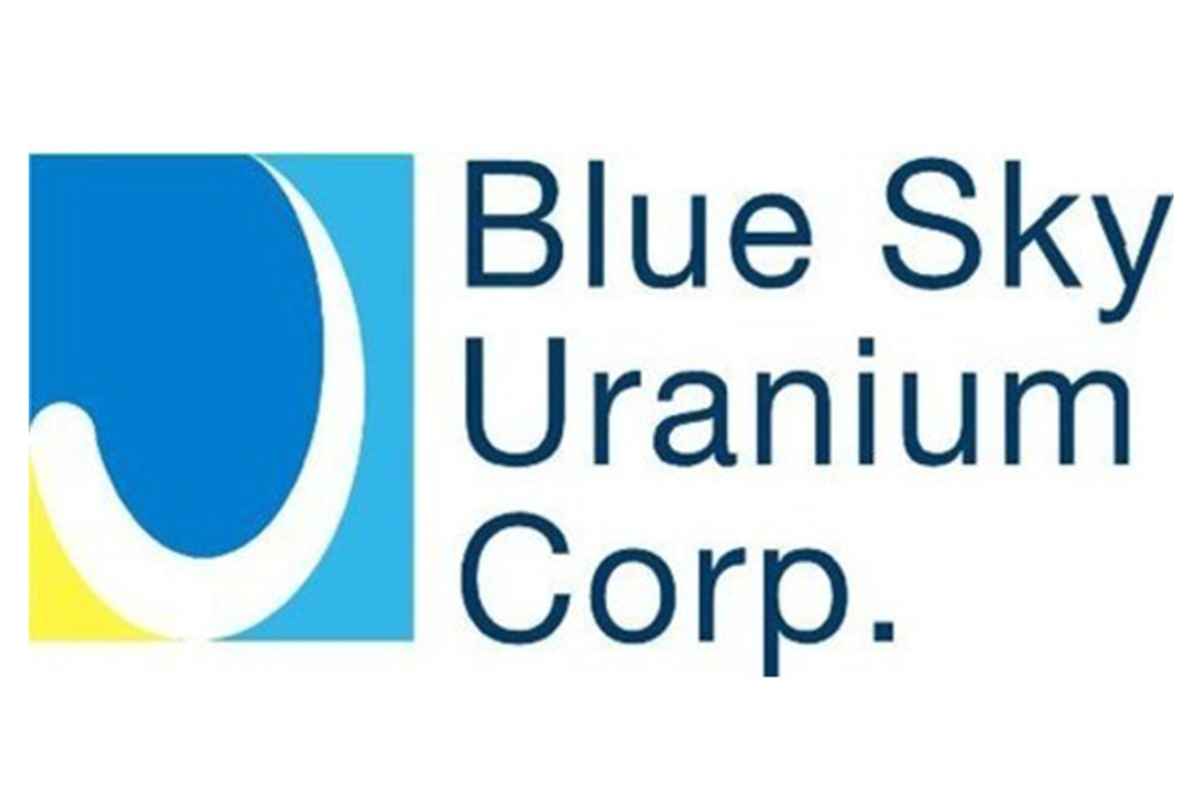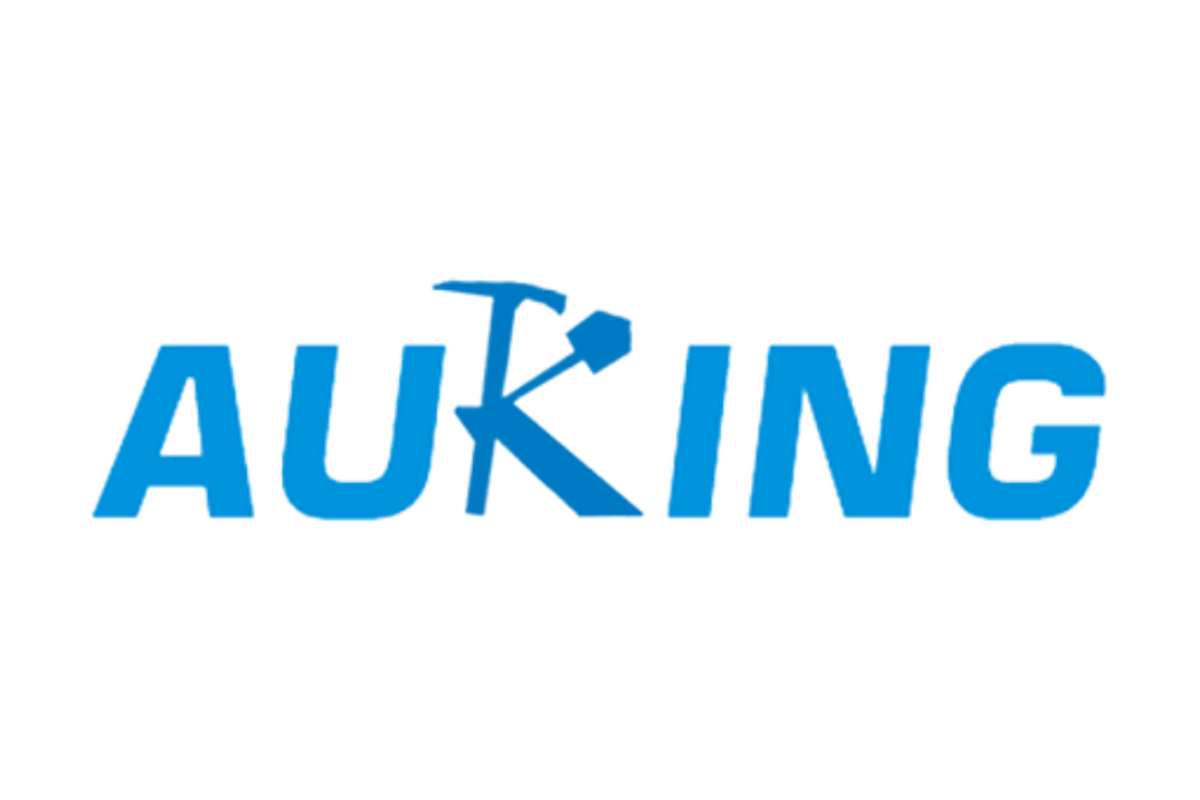
July 28, 2024
AuKing Mining Limited (ASX: AKN) is pleased to advise that it has completed the purchase of the Myoff Creek niobium/REE project in British Columbia, Canada. Project work at Myoff Creek is intended to commence immediately.
AuKing’s Managing Director, Mr Paul Williams, said now the acquisition has been completed the Company would take an aggressive approach to exploration at its new Myoff Creek niobium/REE project.
“We are continuing to see strong interest from investors with companies seeking to develop critical minerals projects, especially niobium and rare earths. The Myoff Creek project presents AuKing with an excellent opportunity to attract some of that investor attention. While we aim to continue with exploration activities at our other projects, including the Mkuju uranium project in Tanzania, the immediate focus of our exploration team will be to generate results from Myoff Creek over the coming weeks,” said Mr Williams.
Myoff Creek Acquisition Terms
AuKing has now completed the acquisition of all the shares in Australian-registered company North American Exploration Pty Ltd (NAE). NAE owns 100% of eight (8) contiguous claims that comprise the Myoff Creek Project. A summary of the acquisition terms is as follows:
- A non-refundable fee of A$50k was paid AKN after signing the agreement (on 22 July 2024);
- In consideration for the acquisition of all the shares in NAE, AKN is obliged to issue 57M new AKN shares at an issue price of 1.5c per share and 28.5M free-attaching options exercisable at 3c on or before 30 April 2027 to the existing NAE shareholders and their nominees; and
- A total of 40M new AKN shares have been issued to the NAE vendors, with the balance 17M shares and 28.5M options to be issued after shareholder approval is obtained at an extraordinary general meeting of AuKing shareholders to be convened as soon as possible (EGM).
Empire Capital Partners Pty Ltd will be paid an introduction fee comprising 10M options exercisable at 3c on or before 30 April 2027 as a result of the NAE option agreement being entered into. The issue of these options is also subject to approval being obtained at the EGM.
Click here for the full ASX Release
This article includes content from AuKing Mining, licensed for the purpose of publishing on Investing News Australia. This article does not constitute financial product advice. It is your responsibility to perform proper due diligence before acting upon any information provided here. Please refer to our full disclaimer here.

Sign up to get your FREE
AuKing Mining Investor Kit
and hear about exciting investment opportunities.
- Corporate info
- Insights
- Growth strategies
- Upcoming projects
GET YOUR FREE INVESTOR KIT
The Conversation (0)
13 April
AuKing Mining
Investor Insight
The Cloncurry Gold project is a portfolio of an existing permitted processing plant, mining and exploration licences that are being acquired by Orion Resources. AuKing has the right to acquire a 50 percent interest in these near-term gold production interests by incurring AU$5 million in expenditure before 30 June 2027.
Overview
AuKing Mining (ASX:AKN) is an exploration and development company with a portfolio of assets focused primarily on gold, but also uranium, copper, and critical minerals, across Australia, Tanzania, and Canada. The company aims to become a mid-tier producer through the acquisition and development of near-term production assets.
In February 2025, AuKing Mining entered into a strategic agreement with Gage Resources, an Australian subsidiary of Beijing-based Gage Capital Management. The agreement includes a $300,000 investment by Gage, resulting in a 10 percent stake in AuKing, and the sale of two non-core prospecting licenses in Tanzania to Gage for an additional $300,000. This partnership is expected to enhance AuKing's financial position and support its ongoing exploration and development activities.
Company Highlights
- AuKing Mining is an exploration and development company with its primary focus being the Cloncurry Gold Project in north Queensland.
- The company also holds a diverse portfolio of exploration assets in Western Australia (Koongie Park), Tanzania (Mkuju), Canada (Myoff Creek in British Columbia and Grand Codroy in Newfoundland).
- Strategic Acquisitions and Partnerships:
- Entered an earn-in agreement to acquire a 50 percent interest in the Cloncurry Gold project.
- Entered a joint venture in February 2025 with ASX-listed Cobalt Blue Holdings (CBH) whereby CBH can earn up to a 75 percent interest in the Koongie Park project in Western Australia.
- Formed a strategic partnership with large Beijing-based resources fund, Gage Capital in February 2025.
- AuKing is led by a highly experienced management team executing the company’s strategies to increase shareholder value.
Key Projects
Cloncurry Gold Project (Queensland, Australia)
In November 2024, AuKing Mining entered into an earn-in agreement with Orion Resources for the Cloncurry gold project in northern Queensland. This agreement allows AuKing to increase its stake in the project to 50 percent by investing AU$5 million in project funding by June 2027.
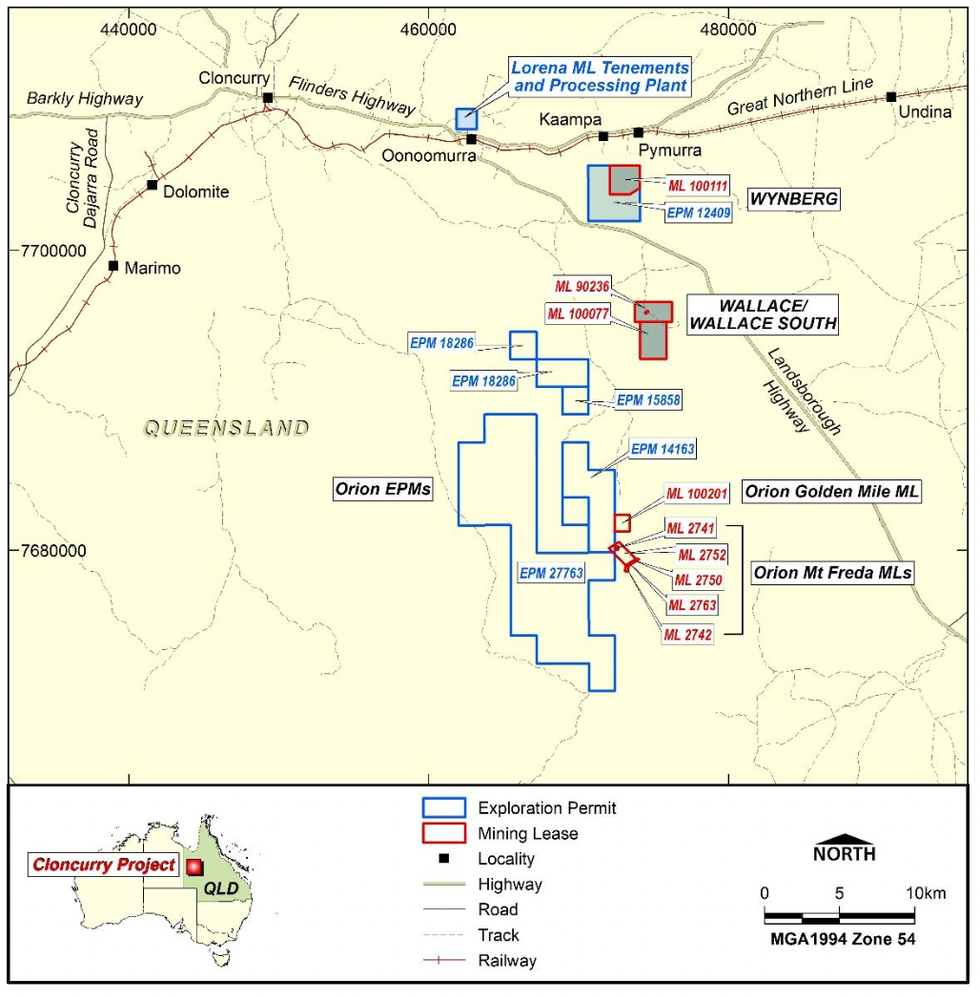
Orion’s Cloncurry Project interests, including the Mt Freda/Golden Mill mining leases. [Note the nearby Wynberg and Wallace/Wallace South gold projects are not assets being acquired by Orion]
A key component of this project is the Tick Hill Gold Joint Venture, involving AuKing, Orion Resources, and Tick Hill Mining, the current owner of the Tick Hill gold mine. The JV aims to establish a processing operation at Tick Hill, focusing initially on reprocessing the existing tailings stockpiles. A pre-feasibility study completed in 2020 outlined a processing capacity of 474,200 tonnes at 2 g/t gold over 13 months, yielding approximately 27,300 ounces of gold at an all-in sustaining cost (AISC) of AU$1,493 per ounce.
In March 2025, the JV partners signed a memorandum of understanding (MoU) to assess the viability of processing Tick Hill's tailings and other ore materials at the Lorena processing plant, located 15 km east of Cloncurry. This initiative aims to expedite the re-commencement of gold production in the region.
The JV also plans to evaluate the feasibility of reopening the historical open pit mine at Tick Hill, with the goal of extending the project's life and enhancing gold production. An independent preliminary economic assessment has concluded that the proposed tailings retreatment plan is both technically and financially viable, recommending progression to a final feasibility study.
Through these strategic initiatives, AuKing Mining is actively advancing the Cloncurry gold project, aiming to unlock significant value and establish a sustainable gold production operation in the Cloncurry region.
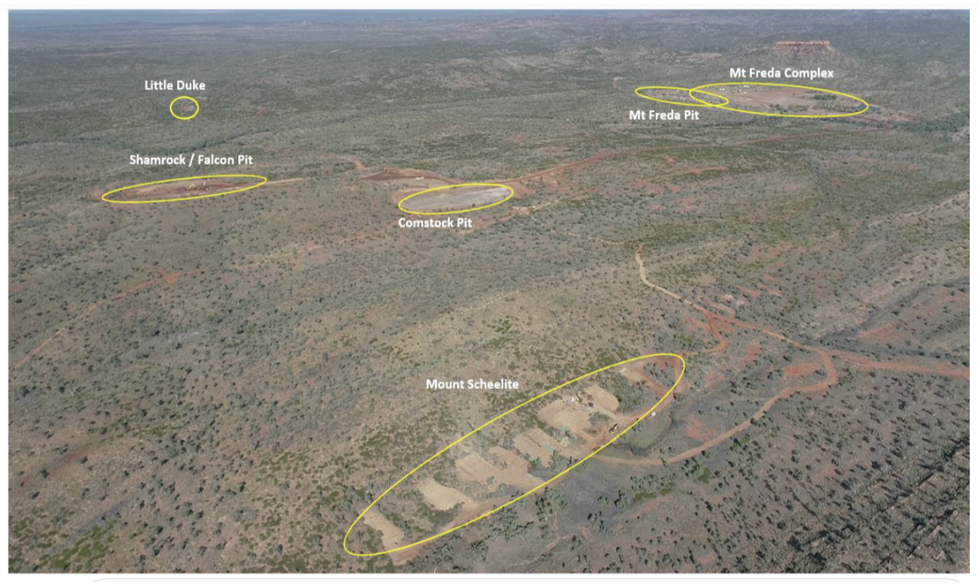
The Mt Freda Complex, covering an area of no more than 6 sq kms, looking from north-west to the south-east, 30kms south of the Lorena plant.
The Mt Freda Mining Complex is a key element in the proposed restart of mining operations at the Cloncurry Gold Project in northern Queensland. A comprehensive drilling program, consisting of an estimated 10,000 meters of combined diamond and reverse circulation (RC) drilling, is planned at Mt Freda to support the project’s development.
Koongie Park Copper-Zinc Project (Western Australia)
Koongie Park project (also known as Halls Creek project) lies within the highly mineralized Halls Creek Mobile Belt. The area also hosts the Savannah (Sally Malay) and Copernicus nickel projects, the former Argyle diamond mine and the Nicolsons gold mining operation of Pantoro Limited. Koongie Park is located about 25 kms southwest of the regional centre of Halls Creek on the Great Northern Highway in northeastern Western Australia.
In February 2025, AuKing entered into a earn-in agreement with Cobalt Blue (ASX:COB) whereby COB can earn up to 75 percent interest in the Koongie Park project.
The project contains three deposits of note: Onedin and Sandiego copper-zinc-gold deposits, and the Emull copper deposit.
Onedin and Sandiego are both in advanced exploration stages with a total mineral resource estimate of 4.8 Mt and 4.1 Mt, respectively, containing copper, zinc, gold, silver and lead. The Sandiego prospect boasts a scoping study (released in June 2023) that highlights an 11-year life of mine with a processing capacity of 750 ktpa and pre-production capex of $135 million for a 2.5 year payback. Economics highlight a pre-tax NPV of $177 million and 40 percent IRR.
The Emull base metal deposit has received significant drilling by previous owner Northern Star Resources several years ago and subsequently by AuKing in 2022. The deposit has a maiden resource estimate of 12.2 Mt, containing copper, zinc, lead and silver, with significant upside potential as more drilling is performed.
Mkuju Uranium Project (Tanzania)
Mkuju is situated immediately to the southeast of the world class Nyota uranium project that was the primary focus of exploration and development feasibility studies by then ASX-listed Mantra Resources (ASX:MRU). Not long after completion of feasibility studies for Nyota in early 2011, MRU announced a AU$1.16 billion takeover offer from the Russian group ARMZ. The takeover was finalised in mid-2011.
During the latter part of 2023, AuKing Mining completed a Stage 1 exploration program at Mkuju which comprised a combination of rock chip, soil geochemistry sampling, shallow auger drilling and initial diamond drilling. Some very encouraging results were obtained from this program which have formed the basis for a 11,000 m drilling program.
Board and Management Team
Peter Tighe – Non-executive Chairman
Peter Tighe started his career in the family-owned JH Leavy & Co business, which is one of the longest established fruit and vegetable wholesaling businesses in the Brisbane Markets at Rocklea. As the owner and managing director of JH Leavy & Co, Tighe expanded the company along with highly respected farms and packhouses that have been pleased to supply the company with top quality fruit and vegetables for wholesale/export for over 40 years. Tighe has been a director of Brisbane Markets Limited (BML) since 1999 and is currently the deputy chairman. BML is the owner of the Brisbane Markets site and is responsible for the ongoing management and development of its $400 million asset portfolio. As the proprietor of the site, BML has over 250 leases in place including selling floors, industrial warehousing, retail stores and commercial offices. BML acknowledges its role as an economic hub of Queensland, facilitating the trade of $1.5 billion worth of fresh produce annually, and supporting local and regional businesses of the horticulture industry.
Paul Williams – Managing Director
Paul Williams holds both Bachelor of Arts and Law Degrees from the University of Queensland and practised as a corporate and commercial lawyer with Brisbane legal firm HopgoodGanim Lawyers for 17 years. He ultimately became an equity partner of HopgoodGanim Lawyers before joining Eastern Corporation as their chief executive officer in August 2004. In mid-2006, Williams joined Mitsui Coal Holdings as general counsel, participating in the supervision of the coal mining interests and business development activities within the multinational Mitsui & Co group. Williams is well-known in the Brisbane investment community as well as in Sydney and Melbourne and brings to the AKN board a broad range of commercial and legal expertise – especially in the context of mining and exploration activities. He also has a strong focus on corporate governance and the importance of clear and open communication of corporate activity to the investment markets.
Mark Fisher – Non-executive Director
Mark Fisher is a highly accomplished resources executive with over 35 years of experience. His skills and experience include strategic business planning, feasibility, project management, organization design, mine engineering and mine management. Mark’s combination of skills and depth of experience has consistently produced profitable and sustainable outcomes in complex settings delivering increased shareholder value.
Mark’s extensive global leadership and operational experience includes senior positions with Placer Dome Inc and Barrick Gold Corporation over a period of decades. In his last corporate role, Mark was President of the Global Copper division for Barrick Gold Corporation, executing the development strategy for its portfolio of key copper assets in South America, Africa, Middle East and Asia.
Dr Kylie Prendergast – Non-executive Director
Kylie Prendergast is an experienced geologist and technical leader with more than 25 years’ experience within the international and resource sector. She currently holds the position of non-Executive Director at Helix Resources Limited (ASX: HLX) and has worked across a range of different operating jurisdictions, including significant in-country assignments and expatriate roles. This has included substantial business development, project technical and economic evaluation, and commercial management including direct interaction with a range of stakeholders in global resource capital markets.
Previously the Managing Director at leading industry consultant Mining Associates, Dr Prendergast has held senior leadership roles with Felix Gold Limited (Managing Director), Mawarid Mining (Oman – GM Exploration and Business development), Batu Mining (Mongolia – Senior Geologist) and Gold Fields St Ives (Project Generation Geochemist). Prior to that she worked in technical geology positions with BHP Billiton, Ivanhoe Mines (Mongolia) and North Limited.
Nick Harding – Non-Executive Director
Nick Harding is a Certified Practicing Accountant (FCPA) with extensive executive and senior management experience across the resources and agribusiness sectors in the areas of finance, commercial, corporate governance and company administration. He possesses significant experience in equity raisings, debt funding, management and statutory reporting, corporate governance, financial modelling and the preparation of feasibility studies.
Nick has held the roles of Executive Director, Chief Financial Officer, and Company Secretary through his professional services company for a number of ASX listed junior exploration companies over the past 16 years, taking some of these through to the evaluation phase and into development and production.
Prior to this, over a 20-year period, Nick has held senior finance management positions within WMC Resources, Normandy Mining/Newmont Australia and Beach Energy across various commodities including gold, copper, nickel, uranium, industrial minerals and oil and gas.
Chris Bittar – Exploration Manager
Chris Bittar was previously senior project geologist at Pantoro Limited’s Norseman Project in Western Australia, where he supervised the planning and execution of near-mine exploration and resource development programs as part of the Definitive Feasibility Study program at Norseman. Prior to his Pantoro role, Bittar held senior geologist roles with Millennium Minerals (Nullagine Gold project) and Pilbara Minerals (Pilgangoora Lithium project), and exploration geologist roles with Sumitomo Metal Mining Oceania and Northern Minerals (Browns Range rare earths project in WA). In these roles, Bittar gained extensive experience in taking projects from greenfield exploration to resource development and up to mine-ready feasibility study stage. This experience included supervision of multiple drilling campaigns, geological interpretation, data management and project reporting. Bittar has also maintained a strong commitment to company safety policies and procedures.
Paul Marshall – Chief Financial Officer and Company Secretary
Paul Marshall is a chartered accountant with a Bachelor of Law degree, and a post Graduate Diploma in Accounting and Finance. He has 30 years of professional experience having worked for Ernst and Young for 10 years, and subsequently twenty years spent in commercial roles as company secretary and CFO for a number of listed and unlisted companies mainly in the resources sector. Marshall has extensive experience in all aspects of company financial reporting, corporate regulatory and governance areas, business acquisition and disposal due diligence, capital raising and company listings and company secretarial responsibilities.
Keep reading...Show less
Advancing the Cloncurry Gold Project in North Queensland, while holding interests in copper, uranium and critical metals assets in other regions.
14h
A$4.5M Placement to Underpin Resource Growth Strategy
26 June
John Ciampaglia: Uranium Turnaround? Spot Price Pop, Stocks and SPUT Raise
John Ciampaglia, CEO of Sprott Asset Management, discusses uranium supply, demand and pricing, also sharing details on the Sprott Physical Uranium Trust's (TSX:U.U,OTCQX:SRUUF) recently closed US$200 million bought-deal financing.
"It's clearly acted as a very positive catalyst — the spot price has popped, a lot of the equities have popped on this," he said about the agreement.
Don't forget to follow us @INN_Resource for real-time updates!
Securities Disclosure: I, Charlotte McLeod, hold no direct investment interest in any company mentioned in this article.
Keep reading...Show less
25 June
North Shore Announces Binding Term Sheet for Rio Puerco Uranium Project in New Mexico, USA
North Shore Uranium Ltd. (TSXV:NSU)("North Shore" or the "Company") is pleased to announce that on June 23, 2025, it signed a binding term sheet (the "Term Sheet") with Resurrection Mining LLC ("Resurrection"), an arm's length party, to acquire up to 87.5% of the Rio Puerco uranium project ("Rio Puerco" or the "Project") in northwestern New Mexico (the "Transaction").
TRANSACTION AND PROJECT HIGHLIGHTS
- Historical resource estimate of 6.0 million tonnes at an average grade of 0.09% eU 3 O 8 for 11.4 million lbs. of U 3 O 8 reported in 2009
- Substantial historical dataset to guide and optimize future exploration programs
- Preliminary review of historical data suggests the potential for In-Situ Recovery ("ISR") mining, the lowest cost method for producing uranium
- Located in the Grants Uranium District, the largest producer of uranium in the United States and near two significant active uranium projects, Marquez-Juan Tafoya (Anfield Energy Inc.) and Cebolleta (Premier American Uranium Inc.)
- Strong US government support for nuclear power and uranium mining projects and a stated objective to reduce reliance on foreign nuclear fuel
- Executive Orders issued by President Trump in late May 2025 include a call for quadrupling US nuclear capacity by 2050, accelerating new reactor development, strengthening the US nuclear fuel supply chain and reforming the US regulatory environment
- Staged earn-in structure allows the Company to optimize exploration programs
- Would provide North Shore with uranium exposure in two North American jurisdictions, the Athabasca Basin in Saskatchewan, Canada and the western USA
Brooke Clements, President and CEO of North Shore stated: "The Rio Puerco project in New Mexico offers us exposure to a uranium project in the USA with excellent upside and signficant historical exploration data including a historical resource estimate. The US government has recently enacted policies designed to accelerate nuclear power and uranium mining activity in the country. In the 1970s, Kerr-McGee commenced mine construction at Rio Puerco, but activity was halted after a short trial-mining phase due to low uranium prices. The Project offers a great opportunity to confirm and expand upon previous work through drilling, modern 3-D modelling and continued assessment of the ISR potential. On completion of the Transaction with Resurrection, we will have uranium exposure in two North American jurisdictions that have seen signficant uranium production, the Grants Uranium District and the Athabasca Basin, at a time when future supply-demand fundamentals look great for the industry."
Rio Puerco is located at the eastern end of the Grants Uranium District, approximately 60 kilometres northwest of Albuquerque, New Mexico (Figure 1). Mines that operated between 1950 and 2002 contributed to make the Grants Uranium District the leading historical uranium producing district in the United States.
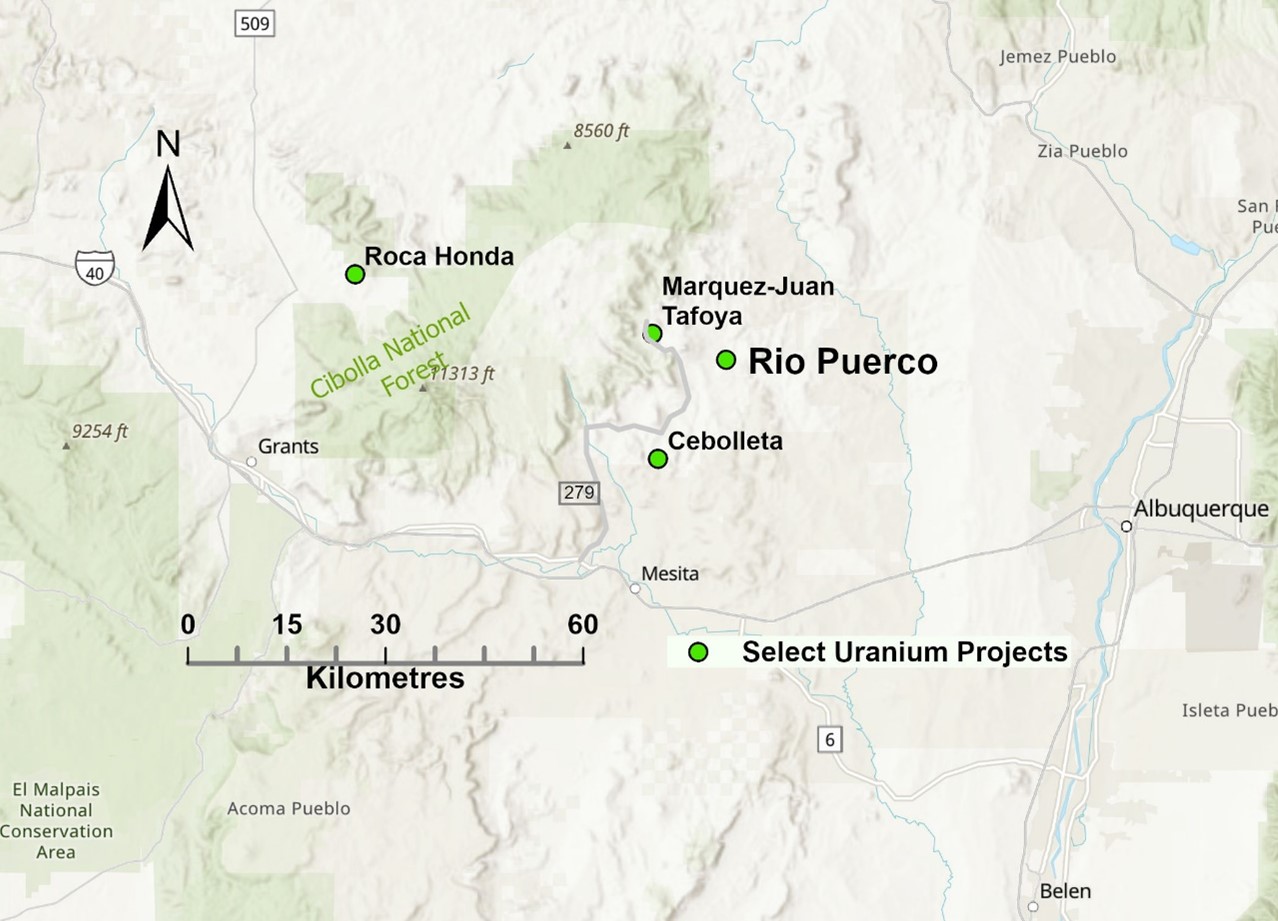
Figure 1: Rio Puerco Location Map, New Mexico. Roca Honda (Energy Fuels), Marquez-Juan Tafoya (Anfield Energy) and Cebolleta (Premier American Uranium) are advanced exploration/development stage uranium projects.
RIO PUERCO PROJECT SUMMARY
Rio Puerco consists of 37 Bureau of Land Management mining claims and significant historic exploration and mining data as well as the rights to a water well. Historical exploration and development work by Kerr-McGee Corporation ( "Kerr McGee" ) in the 1960s and 1970s, and geologic and resource modelling work completed by two Australian companies in 2009 and 2011 validate the potential for Rio Puerco to host a significant uranium resource.
Uranium was first discovered at Rio Puerco in 1968. The claims covering the discovery were ultimately optioned to Kerr-McGee who drilled over 1,000 holes. Based on the results of that work, they began the development of the Rio Puerco Mine in the 1970s. The uranium mineralization is hosted in sandstone of the Jurassic-aged Morrison Formation, host to almost all of the significant uranium deposits in the Grants Uranium District. The mine was intended to be a room and pillar underground mine but was never put into production. Activity ceased after a short trial mining phase likely due to low uranium prices at the time. The underground mine infrastructure included a 260m vertical shaft, ventilation shafts, mining adits and support buildings. The mining shaft remains at the site and road access to the site is excellent.
In 2009, Monaro Mining NL ( "Monaro" ) commissioned an independent geological review and resource estimate for Rio Puerco using exploration data generated by Kerr-McGee in the 1960s and 1970s. The data used for the resource estimate consisted of historical maps and data from 764 drill holes including downhole gamma-ray data converted to percent equivalent U 3 O 8 (e U 3 O 8 ), geological logs and drillhole survey data. They reported a JORC 2004-compliant inferred resource of 6.0 million tonnes at an average grade of 0.09% eU 3 O 8 using a cutoff grade of 0.03% eU 3 O 8 for 11.4 million lbs. of contained U 3 O 8 1 (the " Historic Resource" ). JORC is the Australian Joint Ore Reserves Committee, a professional code of practice that sets minimum standards for public reporting of Mineral Resources.
In 2011, Australian-American Mining Corporation Ltd. commissioned a technical report on Rio Puerco. This most recent report validated and confirmed the Historic Resource 2 .
No significant exploration or development work has occurred at Rio Puerco since the 1970s.
HISTORICAL RESOURCE ESTIMATES FOR THE RIO PUERCO PROJECT
The historical resource outlined in this news release has not been verified and should not be relied upon. It is a historical estimate and not current and does not comply with Canadian NI 43-101 guidelines for the reporting of Mineral Resources. A qualified person has not verified the historical resource on behalf of the Company and North Shore has completed no work programs at Rio Puerco. Though not current, the Company views the historical resource estimates as reliable and sufficient to justify the initiation of work programs aimed at validating and potentially expanding upon the estimates. There is no guarantee that the work programs envisioned by North Shore will ultimately result in the definition of NI 43-101 compliant resources.
RIO PUERCO TERM SHEET
Completion of the Transaction is contingent on North Shore completing satisfactory due diligence, execution of a definitive agreement, completion of a minimum $750,000 financing by North Shore and approval by the TSX Venture Exchange (the "Exchange" ). A finder's fee may be payable to an arms-length third party upon completion of the Transaction. The following highlights key terms of the Term Sheet executed by North Shore and Resurrection, all currency references are in Canadian dollars:
- Milestone 1: upon completion of the Transaction, a $125,000 cash payment and issuance of 9.99% of the issued and outstanding shares of the Company, post-financing.
- Milestone 2, to earn a 40% interest in the Project: on or before 18 months after completion of the Transaction, a $250,000 payment in cash or common shares, at the option of North Shore, and $750,000 in exploration expenditures.
- Milestone 3, to earn an aggregate 65% interest in the Project: on or before 36 months after completion of the Transaction, a $375,000 payment in cash or common shares, at the option of North Shore, and $1,000,000 in additional exploration expenditures.
- Milestone 4, to earn an aggregate 87.5% interest in the Project: on or before 60 months after completion of the Transaction, a $500,000 payment in cash or shares, at the option of North Shore, and $1,500,000 in additional exploration expenditures.
- North Shore may elect to not continue to sole-fund exploration expenditures at any time after earning a 40% interest in Rio Puerco at which time North Shore and Resurrection will enter into a joint venture agreement to govern the funding of Rio Puerco on a proportional basis.
- Carried interest: On completion of Milestone 4, North Shore will provide Resurrection with a 12.5% free-carried interest in the Project through completion of an NI 43-101-compliant Preliminary Economic Assessment at which time Resurrection can elect to form a participating joint venture or convert their interest into a 1.0% net smelter returns royalty. North Shore will be granted a right of first refusal on Resurrection's 12.5% interest.
- Bonus payments: For the 78 month period after completion of the Transaction, North Shore will pay Resurrection a $100,000 bonus for each million lbs. of uranium estimated in current resources defined by the Company above 5 million and up to 20 million lbs. in accordance with NI 43-101 standards, if and when such resources are defined.
- Other terms: Resurrection shall have a participation right to maintain its 9.99% interest in the common shares of North Shore for 5 years from completion of the Transaction and the right, but not the obligation, to appoint one nominee to the North Shore Board of Directors. All share issuances will be subject to Canadian and US securities law and will be priced in accordance with Exchange policies.
NEXT STEPS
After completion of the Transaction, North Shore will begin working towards defining the first NI 43-101-compliant uranium resource at Rio Puerco. The Company's initial work will aim to verify historical data and determine whether a resource can be defined in accordance with NI 43-101. First, geologic models of the previously defined deposit will be prepared using drill hole summary logs containing the interpreted zones of uranium mineralization. A number of confirmation drill holes are required to confirm the historic uranium grade and uranium disequilibrium, and for metallurgical testing. For the first program, 20 to 40 holes are contemplated, a combination of diamond core holes and rotary holes where a downhole gamma ray probe is used to determine uranium content. After the results of that program are received and interpreted, a comprehensive drilling plan would be developed aimed at defining a resource. Data from the drill programs will be used to further evaluate the amenability of ISR mining.
ABOUT NORTH SHORE
The nuclear power industry is in growth mode as more nuclear power will be required to meet the world's ambitious CO 2 emission-reduction goals and the needs of new power-intensive technologies like AI. In this environment, new discoveries of economic uranium deposits will be very valuable, especially in established uranium-producing jurisdictions like Saskatchewan and New Mexico. North Shore is well-positioned to become a major force in exploration for economic uranium deposits. The Company is working to achieve this goal by exploring its Falcon and West Bear properties at the eastern margin of the Athabasca Basin in Saskatchewan, expanding its exploration efforts to include the Grants Uranium District in New Mexico and by evaluating other quality opportunities in the United States and Canada to complement its portfolio of uranium properties. North Shore summarized its exploration efforts at its Falcon property in a May 27, 2025 , news release.
QUALIFIED PERSON
Mr. Brooke Clements, MSc, P.Geol., a Qualified Person as defined by National Instrument 43-101 - Standards of Disclosure for Mineral Projects and the President and CEO of North Shore, has reviewed and approved the scientific and technical disclosure in this press release.
ON BEHALF OF THE BOARD
Brooke Clements,
President, Chief Executive Officer and Director
For further information:
Please contact: Brooke Clements, President, Chief Executive Officer and Director
Telephone: 604.536.2711
Email: b.clements@northshoreuranium.com
www.northshoreuranium.com
Neither the TSX Venture Exchange nor its Regulation Services Provider (as that term is defined in the policies of the TSX Venture Exchange) accepts responsibility for the adequacy or accuracy of this release.
Forward-Looking Statements
This news release contains forward-looking statements that are based on the Company's current expectations and estimates. Forward-looking statements are frequently characterized by words such as "plan", "project", "appear", "interpret", "coincident", "potential", "confirm", "suggest", "evaluate", "encourage", "likely", "anomaly", "continuous" and variations of these words as well as other similar words or statements that certain events or conditions "could", "may", "should", "would" or "will" occur. Such forward-looking statements involve known and unknown risks, uncertainties and other factors that could cause actual events or results to differ materially from estimated or anticipated events or results implied or expressed in such forward-looking statements. Such factors include, among others: the completion and expected terms of the Transaction, the parties' abilities to meet the closing conditions of the Transaction, the number of securities to be issued by the Company in connection with the Transaction, receipt of all necessary approvals for the completion of the Transaction, the completion of satisfactory due diligence, execution of a definitive agreement, completion of a minimum $750,000 or any financing by the Company, and the Company's ability to meet the Milestones, make the bonus payments or meet other terms of the Transaction; the highly speculative nature of the Transaction given the early-stage nature of Rio Puerco; the actual results of current and planned exploration activities including the potential for the definition of a mineral deposit of potential economic value at the Company's Falcon property in Saskatchewan; that drilling results, geophysical survey results and/or interpretations thereof are defining potentially mineralized corridors; results from future exploration programs including drilling; interpretation and meaning of completed and future geophysical surveys; conclusions of future economic evaluations; changes in project parameters as plans to continue to be refined; possible variations in grades of mineralization and/or future actual recovery rates; accidents, labour disputes and other risks of the mining industry; the availability of sufficient funding on terms acceptable to the Company to complete the planned work programs; delays in obtaining governmental approvals or financing; and fluctuations in metal prices. There may be other factors that cause actions, events or results not to be as anticipated, estimated, or intended. Any forward-looking statement speaks only as of the date on which it is made and, except as may be required by applicable securities laws, the Company disclaims any intent or obligation to update any forward-looking statement, whether as a result of new information, future events, or results or otherwise. Forward-looking statements are not guarantees of future performance and accordingly undue reliance should not be put on such statements due to the inherent uncertainty therein. Any forward-looking statements contained in this news release are expressly qualified in their entirety by this cautionary statement.
1 Monaro Mining NL, 2009, 250% increase in uranium resource inventory at Rio Puerco deposit, New Mexico USA: Monaro Mining NL ASX news release: (link)
2 Boyer, D. and Ostensoe, E., 2011, NI 43-101 technical report, Rio Puerco deposit, Sandoval county, New Mexico, USA: Independent report commissioned by Australian-American Mining Corporation Ltd.: (link)
Keep reading...Show less
25 June
Blue Sky Uranium Closes 2nd Tranche of Non-Brokered Private Placement
Blue Sky Uranium Corp. (TSXV: BSK) (FSE: MAL2) (OTC: BKUCF), ("Blue Sky" or the "Company") announces that it has closed a second tranche of the private placement through the issuance of 6,828,300 units of the Company (each, a "Unit") at a price of $0.06 per Unit for aggregate gross proceeds of $409,698 (the "Offering"). To date the Company has issued 27,361,633 Units for aggregate gross proceeds of $1,641,698.
Each Unit consists of one common share and one transferrable common share purchase warrant (a "Warrant"). Each Warrant will entitle the holder thereof to purchase one additional common share in the capital of the Company at $0.075 per share for three (3) years from the date of issue, expiring June 26, 2028.
The Company intends to use the proceeds of the Offering for general working capital.
Finder's fees of $4,108.86 are payable in cash on a portion of the private placement to parties at arm's length to the Company. In addition, 68,481 non-transferable finder's warrants are being issued (the "Finder'sWarrants"). Each Finder's Warrant entitles a finder to purchase one common share at a price of $0.06 per share for three (3) years from the date of issue, expiring on June 26, 2028.
Certain insiders of the Company participated in the Private Placement for $96,000 in Units. Such participation represents a related-party transaction under Multilateral Instrument 61-101 - Protection of Minority Security Holders in Special Transactions ("MI 61-101"), but the transaction is exempt from the formal valuation and minority shareholder approval requirements of MI 61-101 as neither the fair market value of the subject matter of the transaction, nor the consideration paid, exceed 25% of the Company's market capitalization.
This Offering is subject to regulatory approval and all securities to be issued pursuant to the Offering in this second tranche are subject to a four-month hold period under applicable Canadian securities laws expiring on October 26, 2025. The proceeds of the Offering will be used for general working capital.
The securities described herein have not been, and will not be, registered under the United States Securities Act of 1933, as amended (the "1933 Act") or any state securities laws, and accordingly, may not be offered or sold within the United States except in compliance with the registration requirements of the 1933 Act and applicable state securities requirements or pursuant to exemptions therefrom. This press release does not constitute an offer to sell or a solicitation to buy any securities in any jurisdiction.
About Blue Sky Uranium Corp.
Blue Sky Uranium Corp. is a leader in uranium discovery in Argentina. The Company's objective is to deliver exceptional returns to shareholders by rapidly advancing a portfolio of uranium deposits into low-cost producers, while respecting the environment, the communities, and the cultures in all the areas in which we work. Blue Sky's flagship Amarillo Grande Project was an in-house discovery of a new district that has the potential to be both a leading domestic supplier of uranium to the growing Argentine market and a new international market supplier. The Company's recently optioned Corcovo project has potential to host an in-situ recovery ("ISR") uranium deposit. The Company is a member of the Grosso Group, a resource management group that has pioneered exploration in Argentina since 1993.
ON BEHALF OF THE BOARD
"Nikolaos Cacos"
______________________________________
Nikolaos Cacos, President, CEO and Director
Neither TSX Venture Exchange nor its Regulation Services Provider (as that term is defined in policies of the TSX Venture Exchange) accepts responsibility for the adequacy or accuracy of this release.
Keep reading...Show less
19 June
Stallion Uranium: Positioned for Discovery in the World’s Premier Uranium District
Stallion Uranium (TSXV:STUD,OTCQB:STLNF) is a Canadian exploration company focused on unlocking new discoveries in the underexplored southwestern Athabasca Basin—an emerging frontier with exceptional geological potential. With more than 709,000 acres under control, Stallion holds one of the largest land positions among junior explorers in the region.
As global uranium demand accelerates—driven by over 900 reactors in operation, construction, or planning—Stallion is well-positioned to benefit from a growing supply gap. The Athabasca Basin, known for uranium grades up to 20 times the global average, remains the world’s premier jurisdiction for high-grade uranium exploration.
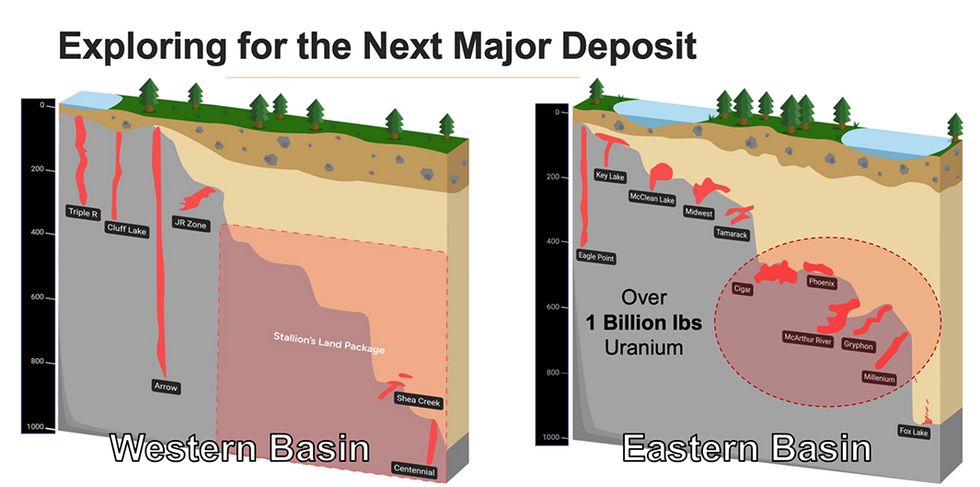
Stallion Uranium holds one of the largest underexplored land packages in the Athabasca Basin, covering more than 709,000 acres in the highly prospective southwestern region. Using advanced geophysics and a proven exploration framework, the company has systematically identified and ranked nine Tier-1 uranium targets across its portfolio. From these, three high-priority corridors have been selected for near-term exploration—each displaying the key geological and structural characteristics associated with major high-grade discoveries in the Basin.
Company Highlights
- Large-scale land position: 709,192 acres in the underexplored southwestern Athabasca Basin.
- World-class exploration address: Athabasca Basin accounts for ~15 percent of global uranium production and hosts the world’s highest-grade deposits.
- Tier-1 targets: Nine high-priority uranium targets identified; three prioritized for near-term drilling: Coyote, Fishhook and Lynx – each defined by advanced geophysics and ideal structural settings.
- Discovery-focused leadership: Team responsible for discoveries including NexGen’s Arrow and Hathor’s Roughrider.
- Strong market fundamentals: Global reactor count rising, while uranium supply remains structurally constrained.
- Near-term catalysts: Drilling at Coyote planned for H2 2025; expanded geophysics underway across portfolio.
This Stallion Uranium profile is part of a paid investor education campaign.*
Click here to connect with Stallion Uranium (TSXV:STUD) to receive an Investor Presentation
Keep reading...Show less
Latest News

Sign up to get your FREE
AuKing Mining Investor Kit
and hear about exciting investment opportunities.
- Corporate info
- Insights
- Growth strategies
- Upcoming projects
GET YOUR FREE INVESTOR KIT
Latest Press Releases
Related News
TOP STOCKS
American Battery4.030.24
Aion Therapeutic0.10-0.01
Cybin Corp2.140.00
